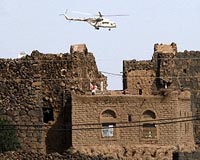| . |  |
. |
Sanaa, Yemen (UPI) Jan 11, 2009 America may be doubling its security aid to embattled President Ali Abdullah Saleh of Yemen to fight al-Qaida, but most of the country's weaponry is coming from Russia, China and former Soviet states in Eastern Europe, with Saudi Arabia providing the funds. According to the Inter Press Service, Yemen's armed forces are undergoing a major military modernization program worth an estimated $4 billion. That's a huge amount for a country whose economy is collapsing, running out of water as well as oil. Production has fallen from 450,000 barrels a day six years ago to barely 1809,000 a day now. Within a decade, its reserves will have run dry, eliminating the country's only real source of income. The only thing keeping Saleh in power -- and business, as official corruption is rampant in a regime whose writ barely runs beyond the capital and some other urban zones -- is Saudi petrodollars and an army where his relatives hold key commands. And right now they're being spent weapons and ammunition -- and the loyalty of tribes who otherwise would be joining al-Qaida, or the rebels in the north, or the secessionists in the south. U.S. President Barack Obama, alarmed at recent terrorists actions that apparently originated with the resurgent al-Qaida franchise in Yemen, has pledged to double U.S. security aid to $150 million to prop up America's erratic ally, Saleh. It's not clear if that will include actual weapons, because if it does it could complicate things. During the Cold War, South Yemen, then a Marxist state, was armed by Moscow. The armed forces have a smattering of U.S. armored personnel carriers, a few aging M60A1 tanks and 10 F-5E fighter jets that are well past their sell-by date. The rest is all Eastern bloc weaponry and equipment. So it's not surprising that, according to the Stockholm International Peace Research Institute that monitors global arms transfers, Russia accounted for nearly 60 percent of all major arms deliveries to Yemen in 2004-08. Ukraine was next with 25 percent. China pitched in with armaments worth $200 million. Another $400 million worth came from Eastern Europe, including Belarus and the Czech Republic. The United States was at the bottom of the list with a paltry 1 percent. According to the Russian media, Yemen signed up with Moscow to purchase weapons worth an estimated $1 billion at the beginning of 2009. Some reports put the total at $2.5 billion. Paul Hortom of the Stockholm Institute's arms transfer program said Saleh is looking for more supersonic MiG-29 interceptor jets, helicopters, tanks and other armored vehicles. These are not likely to be of much use against nimble and elusive guerrilla terrorists, although they will add firepower against the northern tribal rebels and, presumably, against the increasingly violent secessionists down south. Given impoverished Yemen's empty coffers, it can only be assumed that this deal will be paid for by the $2 billion Saudi Arabia gave Saleh a few months ago. The Saudis aren't being so generous because they view Saleh as their dearest ally. They really don't care much for him at all, not since 1962 when as a young army officer he was part of a republican coup that overthrew the Zaidi Shiite imamate in Sanaa -- in what was then North Yemen -- that had ruled for 1,000 years. In the civil war that ensued, the Saudis backed the royalists against the Egyptian-backed republicans -- and lost. In 1978 Saleh, then a colonel, took power. He made things worse with Saudi Arabia -- not to mention the United States -- by being a stalwart supporter of Saddam Hussein when he invaded Kuwait in 1990. The Saudis prop up Saleh because if his highly unpopular regime collapses, Riyadh fears al-Qaida will exploit the ensuing chaos to mount a new offensive against the House of Saud following their failure in 2003-07. Yemen also is strategically located on the southwestern tip of the Arabian peninsula overlooking the oil tanker routes through the Gulf of Aden and the chokepoint Bab el-Mandeb Strait into the Red Sea. The normally cautious Saudis have already committed ground and air forces to hammer the rebels in northern Yemen who threaten the kingdom's porous border. It's the Saudis' first combat operation since 1991. Their numbers, like Saudi treasure to stop Yemen becoming another failed state, may well increase.
Share This Article With Planet Earth
Related Links The Long War - Doctrine and Application
 No plan to send troops to Yemen, Obama says
No plan to send troops to Yemen, Obama saysWashington (AFP) Jan 10, 2010 President Barack Obama says he has "no intention" of sending US troops to fight militants in Yemen and Somalia and that Al-Qaeda's activities are still centered along the Afghanistan-Pakistan border. "I have every intention of working with our international partners in lawless areas around the globe to make sure that we're keeping the American people safe," Obama said in a People interview ... read more |
|
| The content herein, unless otherwise known to be public domain, are Copyright 1995-2009 - SpaceDaily. AFP and UPI Wire Stories are copyright Agence France-Presse and United Press International. ESA Portal Reports are copyright European Space Agency. All NASA sourced material is public domain. Additional copyrights may apply in whole or part to other bona fide parties. Advertising does not imply endorsement,agreement or approval of any opinions, statements or information provided by SpaceDaily on any Web page published or hosted by SpaceDaily. Privacy Statement |